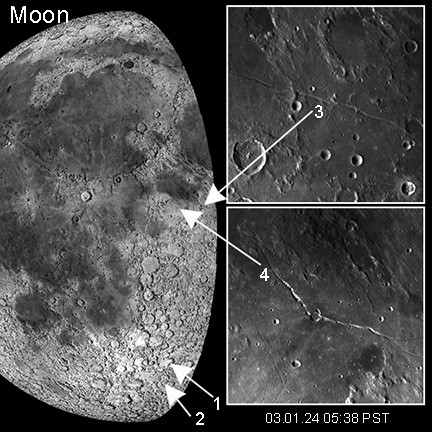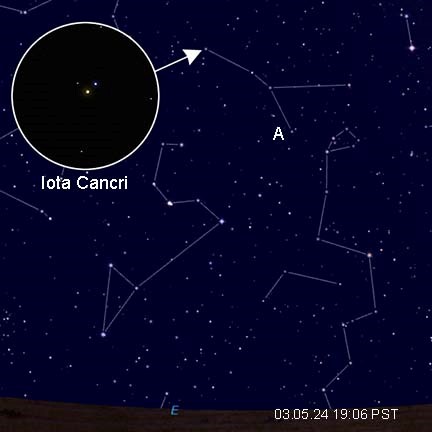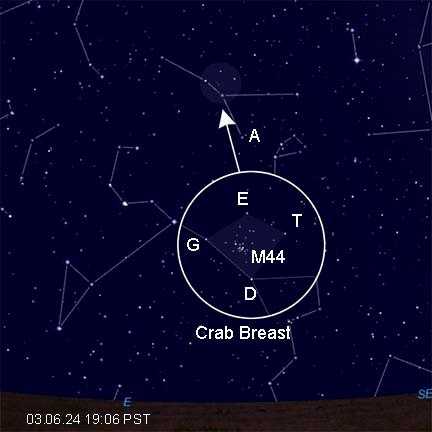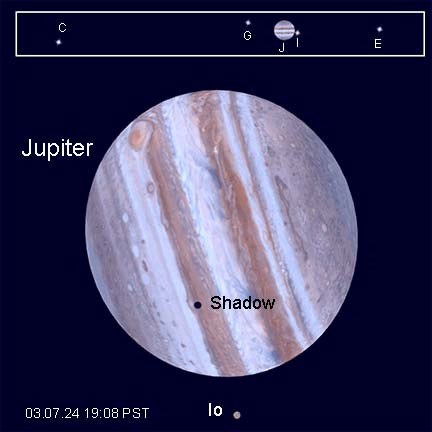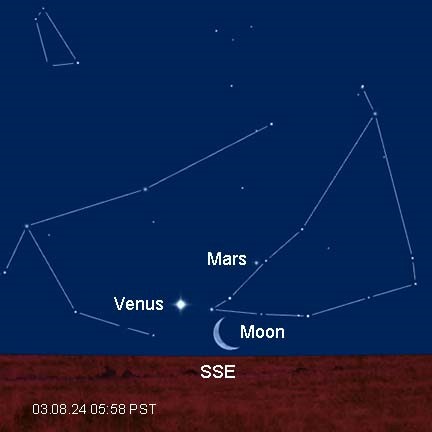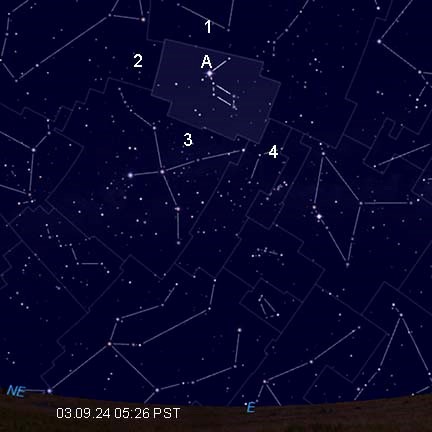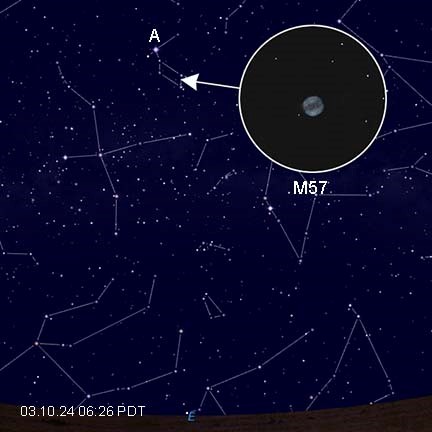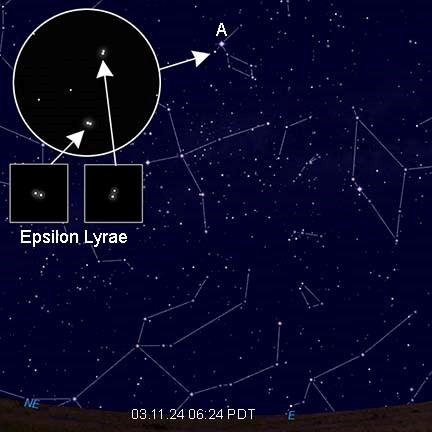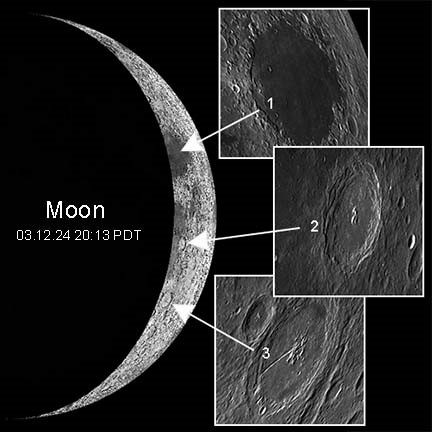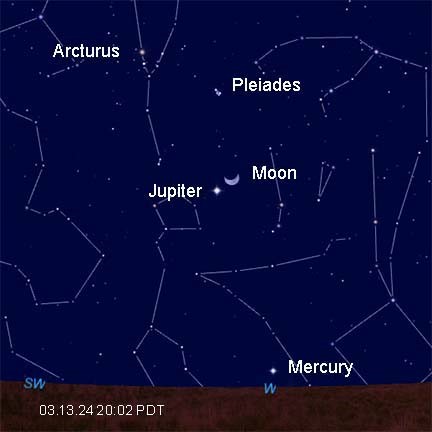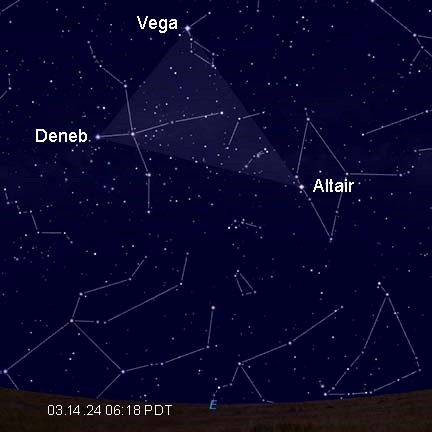The Night Sky Tonight: March 1 – March 14
By Mark Wagner
Mark Wagner brings us highlights of what's happening in the sky each night this week. Click on each image to enlarge the view. Happy gazing!
Friday, March 1
Today's waning gibbous Moon is 70.5% illuminated at 20.61 days. Use your 10X binoculars to view walled plain (1) Stoffler, 76 miles diameter with immense flat stained floor. A 50mm show (2) Crater Heraclitus nearby, circular and 55 miles wide with high craterlet riddled walls, crushed by crater Licetus. A 100mm for (3) Rima Ariadaeus shows the 133 mile east-west rille in superb detail, while just west for 200mm instruments (4) Rima Hyginus seems to continue Ariadaeus southwest to northeast.
Skill Level: Beginner
Suggested Gear: Orion 10x50 E-Series Waterproof Binoculars, Orion SkyScanner BL102mm TableTop Reflector Telescope Kit
Tomorrow Evening: Messier 67
Saturday, March 2
Messier 67 is a beautiful open cluster just west of the (A) alpha star Acubens, past reddish 60 Cancri, magnitude 4.2 and 5.4. This cluster is sometimes referred to as the King Cobra or Golden Eye cluster. This cluster is among the oldest known with age estimates between 3 and 5 billion years. At approximately 2700 light years, you'll find it well populated with 75 stars showing 13 inch apertures. Discovered by Johann Gottfried Koehler in 1779, it was also found by Charles Messier a year later.
Skill Level: Beginner
Suggested Gear: Orion Observer 134mm Equatorial Reflector Telescope, Orion AstroView 6 Equatorial Reflector Telescope
Tomorrow Evening: Juno Opposition
Sunday, March 3
The large asteroid Juno is in opposition today, so you can observe it any time tonight. This is the 3rd discovered asteroid, found by Karl Harding in 1804 and by itself contains 1% of the mass of the asteroid belt. Use (G) Gamma and (A) Alpha Leonis to find (C) Chi Leonis and nearby 59 Leonis. Shown in the upper inset, C and 59 point to Juno's position just below a close an obvious pair of magnitude 7.75 and 8.4 stars. Juno shines at magnitude 8.4, equivalent to one of the pair above. Insets shown are 8 and 1 degrees.
Skill Level: Beginner
Suggested Gear: Orion Observer 134mm Equatorial Reflector Telescope, Orion SpaceProbe 130ST Equatorial Reflector Telescope
Tomorrow Evening: Moon Targets
Monday, March 4
Today's Moon is a waning crescent with 40.3% illumination at 23.61 days. A 10X Binocular shows (1) walled plain Longomontanus in the south, 88 miles diameter with steep slopes and high terraced walls. Famous (2) Crater Copernicus in 50mm is superb, hexagonal with very high terraced walls, steep slopes and three central peaks inside its 56 mile form. 100mm for (3) Hortensius Omega shows several volcanic domes with summit craters. 200mm for (4) Rima Hesiodus' shows it as a 182 mile east-west rectilinear ramified rille.
Skill Level: Beginner
Suggested Gear: Orion Scenix 10x50 Wide-Angle Binoculars, Orion SkyLine 8" Dobsonian Reflector Telescope
Tomorrow Morning: Double Star Iota Cancri
Tuesday, March 5
The double star Iota Cancri is a wide colorful binary showing beautifully in low power eyepieces. Jeremy Perez's sketch shows it as yellow and white in his 6" f/8 Orion Skyview Pro, at 240 times magnification. Measured first in 1777 with the primary at magnitude 4.13 and companion 5.99 and 30.6 arc-seconds separation at PA 308.1, its distance is estimated at 280 light years.
Skill Level: Beginner
Suggested Gear: Orion Observer 134mm Equatorial Reflector Telescope, Orion AstroView 6 Equatorial Reflector Telescope
Tomorrow Evening: Crab Breast Asterism
Wednesday, March 6
Discovering asterisms us always fun and when with just your eyes, can be easy. If you are in darker skies, the Crab Breast asterism consisting of (G) Gamma, (D) Delta, (E) Eta and (T) Theta Cancri is a great example. Magnitudes of 3.9, 4.6, 5.3 and 5.3 respectively can be a test for sharp deep vision. Contained in the asterism is the famous Beehive open cluster M44, which glows at a combined magnitude 3.7, and should be quite easy to notice. An asterism is a group of stars that form a distinctive shape, but does not construe a constellation.
Skill Level: Beginner
Suggested Gear: Orion 2x54 Ultra Wide Angle Binoculars, Orion SkyLine Deluxe Green Laser Pointer
Tomorrow Evening: Io Shadow Transit
Thursday, March 7
Jupiter has a shadow transit by Io as evening darkness deepens tonight. Start watching as soon as you can find Jupiter, as the shadow in on the planet's disk by 17:44 when it is still bright out. Follow in your eyepiece as colors begin to show in the bands and belts, and the black spot from Io becomes more intensely black. At 18:48 Io pops off the leading edge of the disk, which is always an amazing sight. The shadow will egress the disk around 19:51 when Jupiter is at 31 degrees altitude.
Skill Level: Beginner
Suggested Gear: Orion Observer 134mm Equatorial Reflector Telescope, Orion SpaceProbe 130ST Equatorial Reflector Telescope
Tomorrow Morning: Grouping Of Moon, Venus and Mars
Friday, March 8
If you have a flat south-southeast horizon, try to see the fine "bright sky" grouping of the Moon, Venus and Mars before sunrise. The Moon will be a waning crescent with under 5% illumination, horns pointing away from the Sun. Venus should be the marker object to find the Moon, shining brightly at magnitude -3.91, and always the third brightest object in our solar system. And Mars? Well it is the challenge target of the three at magnitude 1.24, sitting next to the star Iota Capricornus dimly showing at magnitude 4.25.
Skill Level: Beginner
Suggested Gear: Lawnchair and naked eyes, no equipment needed
Tomorrow Morning: Constellation Lyra
Saturday, March 9
Lyra is a small constellation containing the bright (A) Alpha star Sirius, fifth brightest overall and second brightest in northern skies. The constellation dates to antiquity, and is among the original 48 defined by astronomer Ptolemy in the 2nd century A.D. 52nd of the 88 in area, it is located between (1) Hercules, (2) Draco, (3) Cygnus and (4) Vulpecula. Deep sky objects include famous M57; the Ring Nebula and the globular cluster M56. The "Double Double" Epsilon Lyrae, a pair of close double stars, is an easy and superb telescope target.
Skill Level: Beginner
Suggested Gear: Orion 2x54 Ultra Wide Angle Binoculars, Orion DeepMap 600 Folding Star Chart
Tomorrow Morning: Messier 57
Sunday, March 10
M57 is the Ring Nebula, perhaps the most well known example of planetary nebulae. Discovered by Charles Messier while searching for comets in 1779, it is bright at magnitude 8.8 and annular, with a dark oval center inside its "Cheerio" or smoke ring shape. Jeremy Perez's fine sketch shows the object at 240 times magnification, and can be found between the end stars of the constellation's parallelogram. Using a narrowband filter such at Orion's Ultrablock will darken the background, enhancing the object's bright shape.
Skill Level: Beginner
Suggested Gear: Orion SkyLine 10" Dobsonian Reflector Telescope, 1.25" Orion UltraBlock NarrowBand Filter
Tomorrow Morning: A Double Double Star
Monday, March 11
Just over one degree from Vega's (A) Alpha star Vega is magnitude 4.5 Epsilon Lyrae, otherwise known as the "Double Double", a multiple star system at approximately 162 light years distance. The main pairs have a wide separation of 206 arc-seconds, and can be seen as a pair with the unaided eye in excellent conditions, and easily separated in a finderscope. The pair E1 has magnitudes of 4.7 and 6.2, 2.6 arc-seconds apart. E2 is a more even pair with magnitudes of 5.1 and 5.5 at a tighter 2.3 arc-second separation. E1 secondary component is also a variable with less than ½ day period!
Skill Level: Beginner
Suggested Gear: Orion SkyScanner BL102mm TableTop Reflector Telescope Kit, Orion SkyQuest XT6 Classic Dobsonian Telescope
Tomorrow Evening: Moon Targets
Tuesday, March 12
Tonight's waxing crescent Moon is at 2.76 days with 11% illumination and 24 degrees above the horizon. Let's work with 10X binocular for a short session. (1) Mare Crisium is a round lunar sea 345 by 375 miles diameter with the Terminator in its western half. Look for wrinkle ridges and uneven lava tones. (2) Crater Langrenus is 80 miles diameter and close to the lunar equator, containing high terraced walls and a double central peak. (3) Crater Petavius is 107 miles in diameter with 10,000 foot terraced walls and a dark lava floor with a 1700 meter central mountain.
Skill Level: Beginner
Suggested Gear: Orion 10x50 E-Series Waterproof Binoculars, Orion 15x70 Astronomical Binocular & HD-F2 Tripod Bundle
Tomorrow Evening: Moon, Jupiter and Mercury
Wednesday, March 13
Watch the skies as dusk darkens to catch Mercury setting due west. Above is a lovely pairing of a waning gibbous Moon at 64.1% illumination, next to Jupiter brightly shining at magnitude -2.12 at over 5-1/2 A.U. from Earth. Overseeing the planetary objects below is the Seven Sisters open cluster the Pleiades.
Skill Level: Beginner
Suggested Gear: Lawnchair and naked eyes, no equipment needed
Tomorrow Morning: Summer Triangle Asterism
Thursday, March 14
The Summer Triangle sure covers a lot of area! Is it the largest asterism in our skies? Bounded by three constellation's alpha stars, Vega in Lyra, Deneb in Cygnus and Altair in Aquila, it also contains portions of Vulpecula, Sagitta and Equuleus ? six constellations for one asterism! And the cherry on top ? the superb bright colored double star Albireo within. An asterism is made of a shape described by stars that is not a constellation. They come in sizes varying from naked-eye to in the eyepiece.
Skill Level: Beginner
Suggested Gear: Orion 2x54 Ultra Wide Angle Binoculars, Orion SkyLine Deluxe Green Laser Pointer
Tomorrow Evening: Moon Targets
Charts from Starry Night Pro. M67 and Epsilon Lyrae sketches by Jeremy Perez. Lunar images from NASA LRO, Other images from Virtual Moon Atlas and Starry Night Pro.
Mark Wagner is a lifelong astronomy enthusiast and deep sky observer in the San Francisco bay area. Visit our Facebook Page if you'd like to post comments, questions, sketches or images you've taken to our Night Sky Tonight post.
sales, new products, and astronomy.


